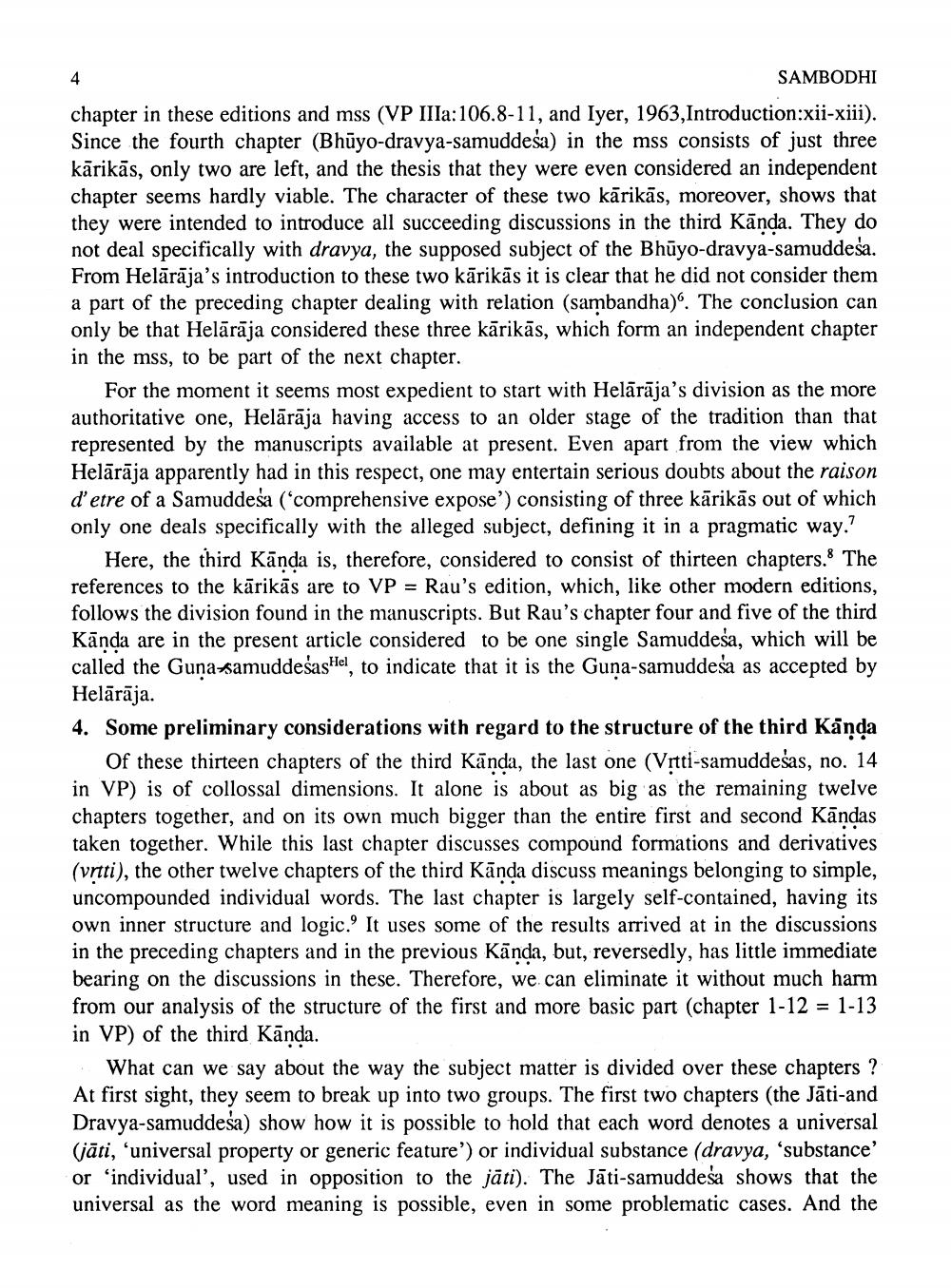________________
SAMBODHI chapter in these editions and mss (VP IIIa:106.8-11, and Iyer, 1963, Introduction:xii-xiii). Since the fourth chapter (Bhūyo-dravya-samuddeša) in the mss consists of just three kārikās, only two are left, and the thesis that they were even considered an independent chapter seems hardly viable. The character of these two kārikās, moreover, shows that they were intended to introduce all succeeding discussions in the third Kānda. They do not deal specifically with dravya, the supposed subject of the Bhūyo-dravya-samuddesa. From Helārāja's introduction to these two kārikās it is clear that he did not consider them a part of the preceding chapter dealing with relation (sambandha)". The conclusion can only be that Helārāja considered these three kārikās, which form an independent chapter in the mss, to be part of the next chapter.
For the moment it seems most expedient to start with Helārāja's division as the more authoritative one, Helārāja having access to an older stage of the tradition than that represented by the manuscripts available at present. Even apart from the view which Helārāja apparently had in this respect, one may entertain serious doubts about the raison d'etre of a Samuddeša ('comprehensive expose') consisting of three kārikās out of which only one deals specifically with the alleged subject, defining it in a pragmatic way.
Here, the third Kānda is, therefore, considered to consist of thirteen chapters. The references to the kārikās are to VP = Rau's edition, which, like other modern editions, follows the division found in the manuscripts. But Rau's chapter four and five of the third Kānda are in the present article considered to be one single Samuddesa, which will be called the Guna-samuddesasHel, to indicate that it is the Guna-samuddesa as accepted by Helārāja. 4. Some preliminary considerations with regard to the structure of the third Kānda
Of these thirteen chapters of the third Kānda, the last one (Vrtti-samuddesas, no. 14 in VP) is of collossal dimensions. It alone is about as big as the remaining twelve chapters together, and on its own much bigger than the entire first and second Kāndas taken together. While this last chapter discusses compound formations and derivatives (vrtti), the other twelve chapters of the third Kānda discuss meanings belonging to simple, uncompounded individual words. The last chapter is largely self-contained, having its own inner structure and logic. It uses some of the results arrived at in the discussions in the preceding chapters and in the previous Kānda, but, reversedly, has little immediate bearing on the discussions in these. Therefore, we can eliminate it without much harm from our analysis of the structure of the first and more basic part (chapter 1-12 = 1-13 in VP) of the third Kānda.
What can we say about the way the subject matter is divided over these chapters ? At first sight, they seem to break up into two groups. The first two chapters (the Jāti-and Dravya-samuddesa) show how it is possible to hold that each word denotes a universal (jāti, ‘universal property or generic feature') or individual substance (dravya, “substance' or 'individual', used in opposition to the jāti). The Jāti-samuddesa shows that the universal as the word meaning is possible, even in some problematic cases. And the




